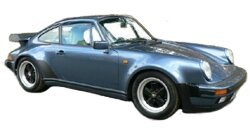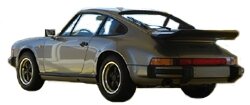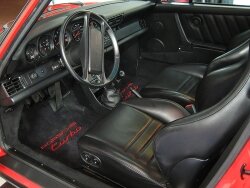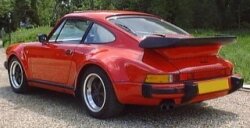Model Page
Porsche 930 (911 Turbo)

|
Production Run: |
21,589 |
|---|---|
|
Production Date: |
1975 - 1989 |
|
Engine: |
Porsche 3.0 Flat Six Turbo (75 – 77) Porsche 3.3 Slat Six Turbo (78 – 89) |
|
Built: |
Zuffenhausen (Germany) |
|
0-60: |
5.0 secs (3.0 Turbo) 4.6 secs (3.3 Turbo) |
|
Max Speed: |
162 mph (3.0 Turbo) 173 mph (3.3 Turbo) |

The Porsche 930 or 911 Turbo as it more widely known was a turbocharged version of the 911 and was available between 1975 and 1989. At the time of launch the car was the first production model to make practical use of turbo-charging technology and it was the fastest production car available in its homeland of Germany. The first version of the 930 produced between 1975 and 1977 was fitted with a 3.0 flat six engine, post 1977 the displacement of the engine was increased to 3.3 litres.

911 Turbo in Blue
Porsche began developing a turbocharged version of the 911 in 1972 with the intention of using the model for Motorsport activities. The 911 turbo project was handed over the Ernst Fuhrmann, he adapted the turbo technology that had originally been developed for the 917/30 CAN-AM car to fit the 3.0 Carrera RS Engine. To meet homologation requirements, road going versions of the car would have to be sold to comply with the regulations. During the development phase, homologation rules changed, rather than stop development Porsche continued on with the intention of producing a range topping 911 that was turbocharged. This car would challenge models produced by Ferrari and Lamborghini by being more exclusive, luxurious and having stronger performance characteristics.
The Porsche 930 was unveiled to the public at the Paris Motors Show in October 1974 with the car officially going on sale in 1975, the car was not available in the US until 1976.
The 930 was based on the G Series platform 911. The main changes to the model were made to the power-plant. The model was fitted with the 3.0 air cooled flat six taken from the Carrera RS 3.0, this unit was chosen as it provided good off boost performance with the lower compression of 6.5:1 that at the time was required for turbo-charging. To this engine a KKK turbo-charger was fitted, the turbo being fixed to a cast aluminium manifold that was studded to the heads. The maximum boost the turbo ran was around 11.5 psi, this coupled with the installation of the Bosch Motronic fuel Injection system increased the power output to around 260 bhp @ 5,500rpm and 245 lb/ft of torque at 4,000 rpm.

Porsche Carrera 3.2
To cope with the increase in power and subsequent performance potential the car underwent an overhaul with larger brakes (Vented Cross Drilled Front Discs, Solid Discs rear), revised suspension, an up-rated 4 speed gearbox. This caused some concern amongst customers as the standard Carrera was available with a give speed box at the time, despite it being a lower model.
Visually, the ubiquitous Whale Tail rear spoiler featuring two grills was added to the car. This gave the car a unique look but also increased the down-force generated by the car at high speed and increased airflow to the engine bay. This spoiler was taken and developed from the 3 litre RSR. The car featured substantially flared wheel-arches to make the car look more aggressive and allow for the installation of larger rear wheel and tyres to increase mechanical grip (245’s were fitted to the rear tyres). The wheel arches were protected from stone chips by black protective strips that are sometimes referred to as shark fins.
The car was fitted with air conditioning, electric windows, full leather interior with sports seats, tinted windows, headlamp washers and Bilstein shocks all as standard. Additional standard fit items included oil cooler, rear window wiper, AM/FM Stereo and electrically operated retracting antenna. The only options available at the time was custom paint, limited slip diff, heavy duty start, Turbo graphic’s and electrically operated sunroof.

930 LHD Interior Cabin
During 1978 the 930 Turbo was revised with a 2mm wider bore that increased the engines displacement to 3,299cc. An air to air intercooler was installed, thus providing a denser air charge into the engine to boost performance. The compression ratio of the engine was increased to 7.0:1, produced around 300 bhp @ 5,500 rpm and 282 lb/ft of toque at 4,000 rpm. The larger engine was fitted to meet emissions regulations around the world.
At the same time the brakes were upgraded to units similar to those used on the 917 race car, these were gripped by four piston callipers. The gearbox was revised with fourth gear being made slightly longer to increase the cars top speed. The rear spoiler was revised and now only had one grille integrated, the spoiler was mounted a little higher on the boot lid to make room for the installation of the intercooler. The new spoiler was visually identifiable by having a curled side and a flat top and was refereed to as the Tea Tray spoiler.
In 1979 the turbo was withdrawn form the US and Japanese markets, in part down to changing emissions regulations, only becoming available once more in 1986. Ernst Fuhrman had cut back investment on the 911 believing that the Porsche 928 would eventually replace the model, it was not until Fuhrman’s departure from the company that the car was re-regulated to be available for sale in the US.
In 1983 a 330bhp version of the 930 Turbo was made available. The changes to the car included a 4 pipe exhaust system, the addition of a second oil cooler that necessitated the modified of the front spoiler, and units bearing the additional ventilation hole in the rear bumpers and modified rockers.

Rear View of a 930 Turbo
In 1985 the car underwent its final revamp. Mechanically the car featured stiffened stabilisers, internally the car featured new seat design with electrical adjustment as standard. The steering wheel was changed to a leather four spoke unit and central locking was fitted as standard.
In 1986 the manufacture of the Turbo body shell was revised, previously the flares had been added to the wings with a series of welds, post 1986 the flared wings were stamped in a single piece. During this model year the Turbo SE or “Flatnose” was released, further information can be found on this model on other pages. During 1987 it was possible to order the car as a Cabriolet, previously the 930 was only available as a Coupe.
The car was described as being very demanding on the drive, due to the rear engine and short wheelbase layout coupled with the high power output the car was prone to over-steer. Sudden burst of power to the rear wheels mid corner could cause the car to spin, the effect was amplified if the driver lifted off the throttle rather than power through the slide.
The Facts
|
Engine: |
Porsche Six Cylinder SOHC |
|---|---|
|
Capacity: |
2,994cc 3,299cc |
|
Valves: |
12 |
|
Compression Ratio: |
3.0 - 6.5:1 3.3 - 7.0:1 |
|
Fuel System: |
Bosch Motronic Injection |
|
Maximum Power: |
3.0 - 260bhp @ 5,500 rpm 3.3 - 300 bhp @ 5,500 rpm |
|
Maximum Torque: |
3.0 - 245lb/ft @ 4,000 rpm. 282lb/ft @ 4,000 rpm |
|
Transmission: |
Manual 4 speed. |
|
Top Gear: |
- |
|
Brakes: |
Servo Assisted Cross Drilled Ventilated Front Discs / Ventillated Rear Discs |
|
Kerb Weight: |
1300kg |
|
Max Speed: |
3.0 - 162 mph 3.3 - 173 mph |
|
0-60: |
3.0 - 5.0 secs 3.3 - 4.6 secs |





